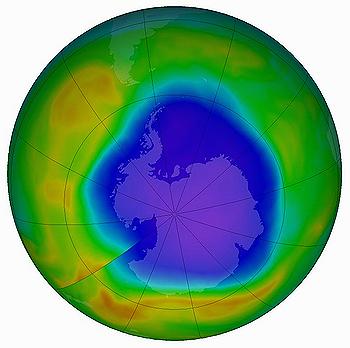
QUITO, Ecuador, November 5, 2018 (ENS) – Actions taken by countries under the Montreal Protocol have led to the start of recovery for the stratospheric ozone layer and the healing of the ozone hole at Earth’s south pole, finds a new UN-backed report released today.
The report finds that the concentration of ozone-depleting substances in the atmosphere continues to decrease, leading to an improvement in the ozone layer since the previous assessment carried out in 2014.

Evidence presented by the authors shows that the ozone layer in parts of the stratosphere has recovered at a rate of one to three percent per decade since 2000.
At projected rates, Northern Hemisphere and mid-latitude ozone is scheduled to heal completely by the 2030s, followed by the Southern Hemisphere in the 2050s and polar regions by 2060.
The Antarctic ozone hole is expected to gradually close, with springtime total column ozone returning to 1980 values in the 2060s.
The study, “Scientific Assessment of Ozone Depletion: 2018,” was presented in Quito at the 30th Meeting of the Parties to the Montreal Protocol. It is the latest in a series of reports, released every four years, which monitor the recovery of ozone in the stratosphere, an atmospheric layer that protects life on Earth from the Sun’s ultraviolet rays.
Among the findings – the atmospheric abundances of both total tropospheric chlorine and total tropospheric bromine from long-lived ozone-depleting substances controlled under the protocol have continued to decline since the 2014 Assessment
The healing of the ozone layer is due to internationally agreed actions carried out under the Montreal Protocol. This international treaty came into being over 30 years ago in response to the scientific discovery that chlorofluorocarbons (CFCs) and other ozone-depleting substances – used in aerosol spray cans, cooling and refrigeration systems – were tearing a hole in the ozone layer, allowing the Sun’s ultraviolet radiation to flood through.
Overexposure to UV radiation may cause skin cancer, damage to the eye and the suppression of the immune system.
The Montreal Protocol has been ratified by 197 parties, including 196 states and the European Union, making it the first universally ratified treaty in UN history.

“The Montreal Protocol is one of the most successful multilateral agreements in history for a reason,” said Erik Solheim, head of UN Environment.
“The careful mix of authoritative science and collaborative action that has defined the Protocol for more than 30 years and was set to heal our ozone layer is precisely why the Kigali Amendment holds such promise for climate action in future,” he said.
Next year, the Protocol is set to be strengthened with the ratification of the Kigali Amendment, which calls for decreasing the future use of powerful climate-warming gases, which also damage the ozone layer.
Set to enter in to force on January 1, 2019, the Kigali Amendment calls for slashing the future use of climate-warming gases in refrigerators, air conditioners and related products. Nations that ratify the Kigali Amendment are committing to cutting the projected production and consumption of these gases, known as hydrofluorocarbons (HFCs), by more than 80 percent.
To date, 59 governments, not including China, India, Russia or the United States, have ratified the Kigali Amendment.
Authors of the assessment released today found the world can avoid up to 0.5°C of global warming this century through implementation of the Kigali Amendment, affirming its critical role in keeping global temperature rise below the 2°C mark.
“These new assessment results highlight the importance of continued long-term monitoring of HFCs in the atmosphere as the Kigali Amendment begins to take hold,” said David Fahey, co-chair of the Montreal Protocol Scientific Assessment Panel and scientist at the NOAA Earth System Research Laboratory in the United States.
Full compliance would reduce future global warming due to HFCs by about 50 percent between now and 2050 compared to a scenario without any HFC controls.
The ozone assessment provides a ray of hope, less than a month after the Intergovernmental Panel on Climate Change, IPCC, released a watershed report which described the devastating effects of a 2°C rise in atmospheric temperature compared to pre-industrial levels.
UN Secretary-General António Guterres called the IPCC report an “ear-splitting wake-up call.”
The writers of the Scientific Assessment of Ozone Depletion: 2018 found that, if the Kigali Amendment is fully implemented, the world can avoid up to 0.4 percent of global warming this century. It will play a major role in keeping the global temperature rise below 2°C.
The assessment is being hailed as a demonstration of what global agreements can achieve, and an inspiration for more ambitious climate action to halt a potential catastrophic rise in world temperatures.
Four future actions that are expected to hasten healing of the ozone layer are proposed in the assessment:
* – Complete elimination of controlled and uncontrolled emissions of substances such as carbon tetrachloride and dichloromethane
* – Bank recapture and destruction of chlorofluorocarbons (CFCs), halons, and hydrochlorofluorocarbons (HCFCs)
* – Elimination of HCFC and methyl bromide production
* – Mitigation of nitrous oxide emissions
The Scientific Assessment of Ozone Depletion: 2018 was prepared by: the World Meteorological Organization; the UN Environment Programme; the U.S. National Oceanic and Atmospheric Administration, NOAA; the National Aeronautics and Space Administration, NASA; and the European Commission.
Copyright Environment News Service (ENS) 2018. All rights reserved.
